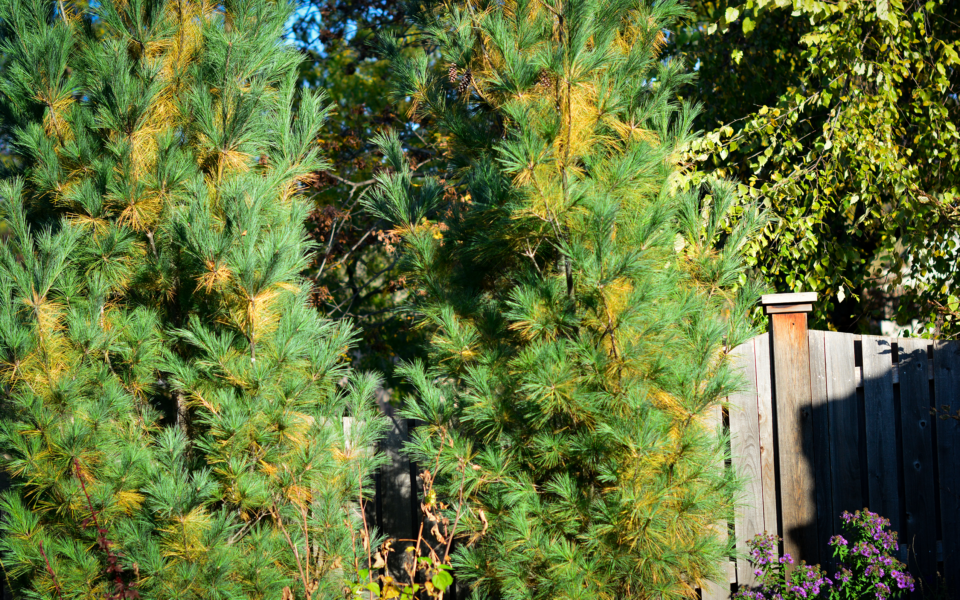My evergreen’s needles are turning yellow/brown and falling, is my tree sick?
The answer is…. it depends. For conifers such as pine, spruce, fir, or arborvitae this may be a natural and healthy occurrence, but it depends. How do you tell the difference, and what should you do? Here’s a few tips:
Needlecast (Picture above) is a natural process for conifer trees (pine, spruce, fir, or juniper). Conifers are not true evergreens, and must shed their needles to stay healthy. This generally happens only in the fall and, while the trees look unhealthy, but there is no need for concern. It will only last a short while. That being said, the yellowing of needles should only occur on the inner portions of branches and not on the tips. Yellowing at the tips may indicate the tree is suffering from sun scald, freeze damage or a possible pest attack.
This is a natural process and usually only persists for a month or two.
Sun scald occurs when extremely dry winter wind combines with low soil moisture and intense sun causes the needles to dry out. It is not very common in the clay soils around Omaha, Gretna, and Fremont, but definitely possible in exposed sites. Telling signs of sun scald are yellowing of needles on just one side of the tree, usually facing the southern sun or prevailing winter winds. It will often be at the tips and not on the inner needles. The tree usually responds and is not killed, but it may look ill into the next season.
Two ways to reduce the risk of sun scald are to:
1. Provide water in the winter. If temperatures persist above 40 degrees for a period for several days it is okay to water in the once or twice a month in the winter.
2. Wilt-pruf spray is an anti-desiccant (reduces moisture loss) that can provide short-term protection from moisture loss through the needles.
Over Watering can be extremely detrimental to conifers even for a short period. Too much water keeps oxygen from the root system which causes the tree to suffocate. Symptoms of too much water include branches that are drooping and yellowing needles throughout the tree. Before watering, test the soil for moisture. Poke your finger into the ground a few inches. If it feels saturated (wet/muddy) refrain from watering, if it is slightly moist, proceed with watering.
Sudden Freeze damage can cause yellowing when temperatures shift from very warm to a hard freeze quickly. Evergreens need time to enact metabolic processes and prepare for cold temperatures. If the temperature shifts from say 65 to 15 over the course of two days, the tree can’t respond quickly enough and can dry out/ be damaged. Tell tale signs are yellowing of the tips only on all sides of the tree. There is not much you can do immediately after it happens, but if buds have developed the tree will usually bounce back, you just need to prune the dead parts in the spring.
Winter watering can help reduce the risk of freeze damage.
[rev_slider Yellowevergreen]
Looking to replace a tree on your property? Need landscaping advise? Our experienced team of horticulturalists and designers can help you choose the right plant in the right place. Contact us for a free consultation.
[gravityform id=”1″ title=”true” description=”false”]
Breaking Ground is a Design/Build Landscape contractor specializing in the residential and specialty commercial markets. Our operations yard is located in Western Douglas County. From this location we proudly serve the greater Omaha metro/rural region to include: Bennington, Blair, Bellevue, Elkhorn, Fremont, Gretna, LaVista, Papillion, Omaha and Valley.
